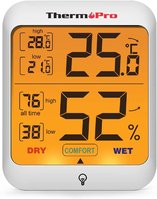Home Guides Guide to the right Temperature and Humidity to ...
Guide to the right Temperature and Humidity to Grows Chili Peppers

WHAT TEMPERATURE SHOULD CHILI PEPPERS BE AT TO SPROUT AND WHEN TO SOW THEM?
To know the temperature and humidity values during the germination phase it is absolutely important to have a thermo-hygrometer, I have repeated it many times but I will do it here too, to obtain 100% germination of all the chili seeds the values to pursue are, 22-24 degrees Celsius of temperature (71-75 F), no more, no less I RECOMMEND, and a value of 90% - 100% Humidity, which can be achieved by placing a kitchen Nylon film over the seedbed.
The right tool for measuring Temperature and Humidity is this: Digital Thermometer / Hygrometer, Humidity and Temperature Meter
To measure temperature and humidity with a probe, the perfect object, at a ridiculous price, is this: Thermometer and Hygrometer with probe
Humidifier to increase the percentage of humidity inside the GrowBox: Humidifier for Chili Pepper Plants in Indoor Cultivation
There are various types of Capsicum with different peculiarities but the main ones are five. The Capsicum Chinense to which all the super hot ones belong such as Carolina Reaper, Trinidad Scorpion Moruga, Naga Morich, Bhut Jolokia, Habanero and so on which are Caribbean plants and the least easy to germinate, but they are also those that can live up to 5 or 6 years, while the chillies accustomed to the Mediterranean climate are usually the Capsicum Annuum such as Cayenne, Diavolicchio and so on which are much less spicy, are easier to germinate but do not last more than two years. Furthermore, Chinense plants take 5 or 6 months to go from seed to fruit, they initially grow very slowly and this is the reason why they are planted first. Let's remember that in a Grow Box where the humidity is usually around 50%, to reach 90% you just need to put a nylon film over the seedbed as seen in the video.
This is what you need to know depending on the Capsicum you plant:
CAPSICUM CHINENSE: they are planted from January to March, the minimum temperature must be 22 degrees, the maximum must not exceed 26 Celsius degrees (71-78 F), humidity around 90%, germination time from a week to a month
CAPSICUM ANNUUM: they are planted from February to April, the minimum temperature must be above 18 degrees and not exceed 26 Celsius degrees (70-78 F), humidity always at 90%, this is the data that never changes, germination time from 5 days to 20 days
CAPSICUM BACCATUM: they are planted from February to April, minimum temperature 20 degrees, do not exceed 26 Celsius degrees (70-76 F), humidity 90%, they take from one to three weeks to germinate
CAPSICUM PUBESCENS: they are planted from January to April, these are the legendary Rocoto chillies from the Andes with black seeds, they often cause difficulties in germination, personally never for me, I simply put them in the least hot corner of the grow box and not above the source of heat such as a mat or heating wire, these are the chillies that best tolerate the cold and therefore, unlike the Caribbean ones, they love shade, hill cultivation and cool temperatures. They are very slow in the early stages so I usually plant them first, minimum temperature 18 degrees and no higher than 22 Celsius degrees (68-72 F), humidity 90%, they take a week to 4 weeks to germinate.
CAPSICUM FRUTESCENS: they are planted from February to April, Tabasco, Malagueta and Piri Piri African Devil belong to this category, temperature between 20 and 26 Celsius degrees max (70-77 F), humidity always around 90% and they take from one to 3 weeks to germinate
I also link videos in which I show how the temperature of the grow box can be different from the actual temperature of the Seed in the soil under the nylon film, take a look at it because there are various tips: Video on Temperature and Humidity in Cultivation of all types of Chili Pepper - SemiStrani.it






